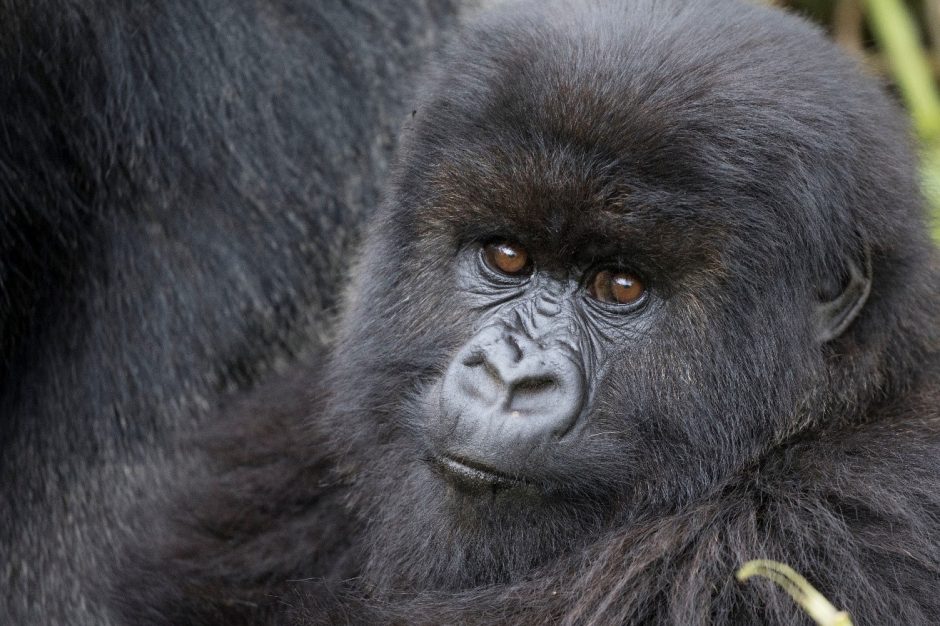
How to Get this Shot – Gorilla “Filling the Frame”
I’m just returning after a sensational photo expedition to Uganda and Rwanda and can’t wait to share photos from the field, as well as techniques for how to get incredible photos of mountain gorillas. If you’re headed on a photographic adventure to Uganda and Rwanda, take a look at the tips below for how to get a “fill the frame” style shot like the one above.
- In order to photograph rare mountain gorillas, you’ve of course got to locate them. Fortunately, wildlife authorities in both Uganda and Rwanda have done good things in protecting their last remaining habitat. And, through near-constant surveillance, trackers know each day where these magnificent animals can be found. But to get a truly extraordinary experience, try and link up with a special photographic trip so that you maximize your experience and get on-site help while photographing the gorillas.
- One of the biggest challenges to photographing gorillas is their habitat. In Uganda, their home is actually called Bwindi Impenetrable Forest. It is indeed a jungle. Thus, it’s challenging to get photos without also photographing lots of distractions like vines, leaves, and various other types of foliage and textures. There are several techniques to isolate your subject, which I’ll get to in subsequent posts, but an easy tactic right off the bat is to fill the frame with the animal. That is, try and get as little background as possible to minimize distractions.
- To accomplish this, it’s helpful to have a decent telephoto zoom lens with you. Despite the fact that you’ll likely be quite close to the gorillas, a telephoto helps you focus solely on the face of the animal. While 200mm or 300mm lenses will indeed get you great photos of gorillas, lenses that get up into the 400mm range can really help you fill the frame with these fuzzballs. Notice how in this particular shot I’m oriented such that another larger gorilla is just behind this young one, to the left. This helps create a unifying color, light and texture, instead of the brighter yellow, harsher lit, and differently textured background the forest and foliage could give the photo.
- The other way to minimize background distraction is to shoot with a wider aperture setting. While something like f/2.8 or f/4 could be great, not all lenses have the capability to go that wide and instead we’re stuck with f/5.6 or f/6.3. This is ok, you just have to be even more cognizant of getting that ideal background color and lighting, since you won’t get as much blur with an f/5.6 or f/6.3 setting.
- So much of the brilliance of gorilla photography comes down to the expressions they make, particularly with the eyes. The little guys are a bit more curious, and they’ll often look directly at you, while the older ones tend to disregard we humans. In both cases, you should plan on shooting on burst mode, maximizing the number of photos you take per second. Slight differences in expression come about quickly, so having several photos that document a specific moment can be wildly helpful when picking out your favorites post-trip.
- While this may belong at a step earlier on in the process, you will want to constantly monitor your exposure of shots. Animals with distinctly dark or light fur tend to play games with our cameras’ exposure meters. In the case of gorillas, cameras set to “even” metering (i.e., not plus or minus any exposure compensation) tend to increase the lightness of the black fur such that they, and the background, get artificially brightened, or “blown out” in photographer-speak. Thus, I usually choose to go into the session with an underexposure of about -1/3 or -2/3 of a stop, to help the photo be as accurate as my eyes with the proper colors and brightness. However, do be mindful, as lighting schemes change. Throughout the course of your visit each day, you may need to underexpose further, or bring it back to zero based on what the sun and clouds are doing for shadows and bright spots.
And that’s it — easy, right!? Somewhat kidding here, as gorillas are both some of the easiest wildlife to photograph and some of the hardest, all at the same time. While they can be playful and interactive mere feet from you and your camera, the lighting and environment can pose distinct challenges. Thus, the photo showcased here is certainly something to aim for, since it helps abate the issues of a highly textured and deferentially lit environment. When in doubt, just remember to “fill the frame.”
If you’re headed out on a Gorilla photo safari soon, I wish you the best. If you haven’t yet decided on whether this type of photo expedition is right for you, leave a comment below and I’ll be happy to weigh in!
All the best,

Court
Leave a reply